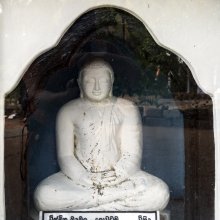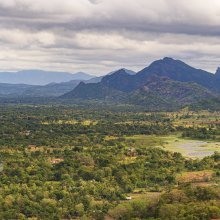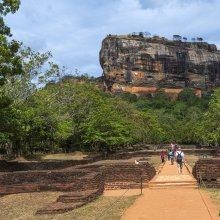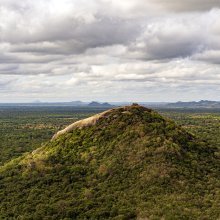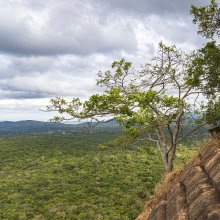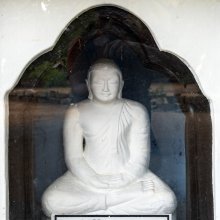Kassapa: 2 definitions
Introduction:
Kassapa means something in Buddhism, Pali. If you want to know the exact meaning, history, etymology or English translation of this term then check out the descriptions on this page. Add your comment or reference to a book if you want to contribute to this summary article.
Images (photo gallery)
(+1 more images available)
In Buddhism
Theravada (major branch of Buddhism)
Source: Pali Kanon: Pali Proper Names1. Kassapa Buddha - Also called Kassapa Dasabala to distinguish him from other Kassapas.
The twenty fourth Buddha, the third of the present neon (the Bhaddakappa) and one of the seven Buddhas mentioned in the Canon (D.ii.7).
He was born in Benares, in the Deer Park at Isipatana,
of brahmin parents, Brahmadatta and Dhanavati, belonging to the Kassapagotta.
For two thousand years he lived in the household, in three different palaces, Hamsa, Yasa and Sirinanda. (The BuA.217 calls the first two palaces Hamsava and Yasava).
He had as chief wife Sunanda, by whom he begot a son, Vijitasena.
Kassapa left the world, traveling in his palace (pasada), and practiced austerities for only seven days.
Just before his Enlightenment his wife gave him a meal of milk rice, and a yavapala named Soma gave him grass for his seat.
His bodhi was a banyan tree, and
he preached his first sermon at Isipatana to a crore of monks who had renounced the world in his company.
He performed the Twin Miracle at the foot of an asana tree outside Sundaranagara.
He held only one assembly of his disciples; among his most famous conversions was that of a yakkha, Naradeva (q.v.).
His chief disciples were Tissa and Bharadvaja among monks, and Anula and Uruvela among nuns, his constant attendant being Sabbamitta.
Among his patrons, the most eminent were Sumangala and Ghattikara, Vijitasena and Bhadda.
His body was twenty cubits high, and,
after having lived for twenty thousand years, he died in the Setavya pleasance at Setavya in Kasi.
Over his relics was raised a thupa one league in height, each brick of which was worth one crore.
It is said (MA.i.336ff ) that there was a great difference of opinion as to what should be the size of the thupa and of what material it should be constructed; when these points were finally settled and the work of building had started, the citizens found they had not enough money to complete it. Then an anagami devotee, named Sorata, went all over Jambudipa, enlisting the help of the people for the building of the thupa. He sent the money as he received it, and on hearing that the work was completed, he set out to go and worship the thupa; but he was seized by robbers and killed in the forest, which later came to be known as the Andhavana.
Upavana, in a previous birth, became the guardian deity of the cetiya, hence his great majesty in his last life (DA.ii.580; for another story of the building of the shrine see DhA.iii.29).
Among the thirty seven goddesses noticed by Guttila, when he visited heaven, was one who had offered a scented five spray at the cetiya (J.ii.
Theravāda is a major branch of Buddhism having the the Pali canon (tipitaka) as their canonical literature, which includes the vinaya-pitaka (monastic rules), the sutta-pitaka (Buddhist sermons) and the abhidhamma-pitaka (philosophy and psychology).
General definition (in Buddhism)
Source: WikiPedia: BuddhismIn Buddhist tradition, Kassapa is the name of a Buddha, the third of the five Buddhas of the present aeon (the Bhaddakappa or Fortunate Aeon), and the sixth of the six Buddhas prior to the historical Buddha mentioned in the earlier parts of the Pali Canon(D.ii.7). In the Buddhist texts in Sanskrit, this Buddha is known as Kasyapa.
See also (Relevant definitions)
Starts with: Kassapa Samyutta, Kassapa Sutta, Kassapa Vihara, Kassapa-pasada, Kassapagiri, Kassapagiri-vihara, Kassapagotta, Kassapagotta Or Cheta Sutta, Kassapakarama, Kassapamandiya Jataka, Kassaparajaka, Kassaparajaka-vihara, Kassaparama, Kassapasena, Kassapasena-vihara, Kassapasihanada Sutta.
Ends with: Acela Kassapa, Darukassapa, Dasabala Kassapa, Gaya Kassapa, Girikassapa, Kumara-kassapa, Lomasakassapa, Mahakassapa, Nadi Kassapa, Purana Kassapa, Uruvela-Kassapa.
Full-text (+422): Kassapasena, Kassapa Samyutta, Silameghapabbata, Sakkasenapati, Tebhatika Jatila, Tissarama, Uruvela-Kassapa, Dasabala Kassapa, Kalavilangika, Lomasakassapa Jataka, Acela Sutta, Kassapa Sutta, Kassapa-pasada, Vanijjagama Vihara, Kumara Kassapa Vatthu, Subhakuta, Kumara-kassapa, Bodhi, Senamagama, Upassaya Sutta.
Relevant text
Search found 52 books and stories containing Kassapa; (plurals include: Kassapas). You can also click to the full overview containing English textual excerpts. Below are direct links for the most relevant articles:
Vinaya Pitaka (3): Khandhaka (by I. B. Horner)
On the miracles at Uruvelā < [1. Going forth (Pabbajjā)]
Allowance to proclaim by clan < [1. Going forth (Pabbajjā)]
Origin of the Council < [21. (Recitation with) Five Hundred (Pañcasata)]
The Great Chronicle of Buddhas (by Ven. Mingun Sayadaw)
Chapter 14 - Conversion of the Hermit Brothers and their one thousand Ascetics < [Volume 2.2]
Biography (31): Uruvela Kassapa Mahāthera < [Chapter 43 - Forty-one Arahat-Mahatheras and their Respective Etadagga titles]
Buddha Chronicle 24: Kassapa Buddhavaṃsa < [Chapter 9 - The chronicle of twenty-four Buddhas]
Maha Kassapa (by Hellmuth Hecker)
Part 4 - How Kassapa Came To The Buddha
Part 5 - Kassapa's Relationship To The Buddha
The Gospel of Buddha (by Paul Carus)
Chapter 19 - Kassapa, The Fire-worshiper
Chapter 55 - One Essence, One Law, One Aim
The Catu-Bhanavara-Pali (critical study) (by Moumita Dutta Banik)
(1) Mahakassapa Thera Bojjhanga < [Chapter 3 - Subject Matter of the Second Bhanavara]
(3) Mahacunda Thera Bojjhanga < [Chapter 3 - Subject Matter of the Second Bhanavara]
(5) Isigili Sutta < [Chapter 3 - Subject Matter of the Second Bhanavara]
The Book of Protection (by Piyadassi Thera)
Discourse 12 - Factors Of Enlightenment < [Discourses]
Discourse 13 - Factors Of Enlightenment < [Discourses]
Discourse 5 - Protection Of The Aggregates < [Discourses]
